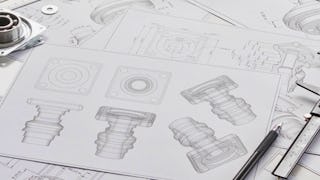Hello, everyone! Welcome to this course on Adding Electronics to Rapid Prototypes. This is part of the Rapid Prototyping and Tooling specialization. In this course, I’ll cover the basics of electric circuits, breadboards, and multimeters. I’ll then discuss different options for connecting electrical components as well as discuss different types of motors and actuators. Finally, I’ll end this course by discussing microcontrollers and how to use them to make even more sophisticated prototypes.

Unlock access to 10,000+ courses with Coursera Plus. Start 7-Day free trial.


Adding Electronics to Rapid Prototypes
This course is part of Rapid Prototyping and Tooling Specialization

Instructor: Daniel Frank
1,532 already enrolled
Included with
(19 reviews)
Recommended experience
What you'll learn
You will learn how to incorporate electronic components in your rapid prototypes.
Skills you'll gain
Details to know

Add to your LinkedIn profile
9 assignments
See how employees at top companies are mastering in-demand skills

Build your subject-matter expertise
- Learn new concepts from industry experts
- Gain a foundational understanding of a subject or tool
- Develop job-relevant skills with hands-on projects
- Earn a shareable career certificate

There are 5 modules in this course
Hello, everyone! Welcome to this course on Adding Electronics to Rapid Prototypes. This is part of the Rapid Prototyping and Tooling specialization. In this course, I’ll cover the basics of electric circuits, breadboards, and multimeters. I’ll then discuss different options for connecting electrical components as well as discuss different types of motors and actuators. Finally, I’ll end this course by discussing microcontrollers and how to use them to make even more sophisticated prototypes. By exploring both electrical simulations and many examples from different robotics projects I’ve had the opportunity to work on, by the end of this course, you should have a better understanding of the basics of electronics and how to add them to your designs to create high-quality prototypes. We have a lot of great content to cover, so without further ado, let’s dive into the world of rapid prototyping!
What's included
3 videos2 readings
In this module, you will learn about the basics of electric circuits, breadboards, and multimeters.
What's included
6 videos2 assignments
In this module, you will learn about different options for connecting electrical components.
What's included
2 videos2 assignments
In this module, you will learn about different types of actuators and how to select and control a DC motor.
What's included
6 videos2 assignments
In this module, you will learn about microcontrollers and how to use them to make sophisticated prototypes.
What's included
3 videos3 assignments
Earn a career certificate
Add this credential to your LinkedIn profile, resume, or CV. Share it on social media and in your performance review.
Instructor

Offered by
Explore more from Mechanical Engineering
 Status: Free Trial
Status: Free TrialUniversity of Colorado Boulder
 Status: Free Trial
Status: Free TrialArizona State University
 Status: Free Trial
Status: Free TrialArizona State University
 Status: Free Trial
Status: Free TrialArizona State University
Why people choose Coursera for their career




Learner reviews
19 reviews
- 5 stars
89.47%
- 4 stars
10.52%
- 3 stars
0%
- 2 stars
0%
- 1 star
0%
Showing 3 of 19
Reviewed on Sep 9, 2023
this course is the basics of adding a electronics to the actual prototype. A basis introduction to microcontroller and arduino, their pins and the basics of programming.

Open new doors with Coursera Plus
Unlimited access to 10,000+ world-class courses, hands-on projects, and job-ready certificate programs - all included in your subscription
Advance your career with an online degree
Earn a degree from world-class universities - 100% online
Join over 3,400 global companies that choose Coursera for Business
Upskill your employees to excel in the digital economy
Frequently asked questions
To access the course materials, assignments and to earn a Certificate, you will need to purchase the Certificate experience when you enroll in a course. You can try a Free Trial instead, or apply for Financial Aid. The course may offer 'Full Course, No Certificate' instead. This option lets you see all course materials, submit required assessments, and get a final grade. This also means that you will not be able to purchase a Certificate experience.
When you enroll in the course, you get access to all of the courses in the Specialization, and you earn a certificate when you complete the work. Your electronic Certificate will be added to your Accomplishments page - from there, you can print your Certificate or add it to your LinkedIn profile.
Yes. In select learning programs, you can apply for financial aid or a scholarship if you can’t afford the enrollment fee. If fin aid or scholarship is available for your learning program selection, you’ll find a link to apply on the description page.
More questions
Financial aid available,

